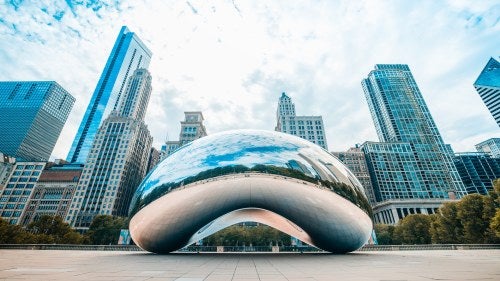Chicago's New Regional Plan: Big Talk, Smaller Walk

The product of a three-year effort, the Chicago Metropolitan Agency for Planning's On to 2050 plan stresses big ideas but tells a more modest story.
If you attended the unveiling of the Chicago Metropolitan Agency for Planning’s new On To 2050 plan earlier this month, you might think it an audacious effort to solve the region’s extraordinary problems in transformational fashion. The Millennium Park event featured a who’s who of regional power players: Mayor Rahm Emanuel, Cook County Board President Toni Preckwinkle, and too many county, state, and local leaders to name. Klieg lights and cameras covered the stage. The keynote speaker, National League of Cities CEO Clarence Anthony, invoked Chicago’s “I will” spirit. Even the Twitter hashtag, #2050BIGIDEAS, stressed the point: this is a bold, splashy blueprint for the region’s next three decades.
The plan itself tells a more modest story.
The product of a three-year effort, On To 2050 incorporates plenty of good ideas. It upholds three worthy principles: inclusive growth, resilience, and prioritized investment. It calls for vital new funding mechanisms, preparation for climate change, and addressing racial and economic inequities. It is based on mountains of research. There is much to laud.
But a citizen expecting bold transformations will be disappointed. Some of the meekest proposals? The region should be more walkable, according to CMAP. This is a worthy goal, but the plan sets a target of only 45% of residents living in walkable places in 2050, a whopping 3.7% change compared to today. Likewise, On To 2050 bemoans that vehicles carrying one person make seven in ten trips to and from work, generating congestion and emissions. By 2050, it sheepishly proposes, policymakers should aim to make it 6.3 of ten trips. That figure falls far short of visionary, and the highway expansion projects endorsed by CMAP are likely to undercut that goal.
Other proposals fit a different model: ambitious targets, but with plans that appear inadequate for the task. For example, On To 2050 endorses a national campaign to eliminate all traffic fatalities by 2050. Great—but how? Redesigning streets is a good start, but the plan offers no tools for enforcement or funding. No matter; an aspirational graph depicts a linear drop from the region’s current 426 annual fatalities to zero in 2050. It’s the planner’s version of The Secret: if you graph it, it will come true.
What accounts for these less-than-inspiring proposals? It’s hard to blame CMAP. Planning for an entire metropolitan region is hard, and doubly so in today’s context. The core idea of regional planning, that the metropolitan area has shared concerns which it must address together, often confronts the reality of local parochialism. The agency has no legislative power; it simply coordinates hundreds of municipalities, seven counties, the state government, and regional bodies such as the Regional Transportation Authority and Metropolitan Water Reclamation District. Planners must manage opposing views and divergent priorities. Sometimes sights must be lowered.
But the limitations of On To 2050 also reflect the constraints of its time and place. If Daniel Burnham and Edward Bennett’s 1909 Plan of Chicago revealed the city’s boom-time optimism, ON TO 2050 shows a region coping with financial stress and state and federal dysfunction. Springfield has not produced a capital budget in ten years, hamstringing the region’s ability to undertake big, vital projects—a point which a frustrated Mayor Emanuel made on stage. Federal support is no longer reliable, and it may never be again.
For all its big talk, On To 2050 concedes these constraints. Many proposals deal less with creating a better future than preventing the deterioration of what already exists. The third pillar of the plan, prioritizing investment, implies these limits of budget and vision. It reminds us that regular maintenance of infrastructure is better than deferred maintenance and that one visionary idea over the next 32 years should be to figure out how to pay for it. Chicagoland must “spend our limited dollars wisely,” as CMAP President Joseph Szabo put it. Such plans may stir no blood, but for better or worse, they accept the realities of the moment.

